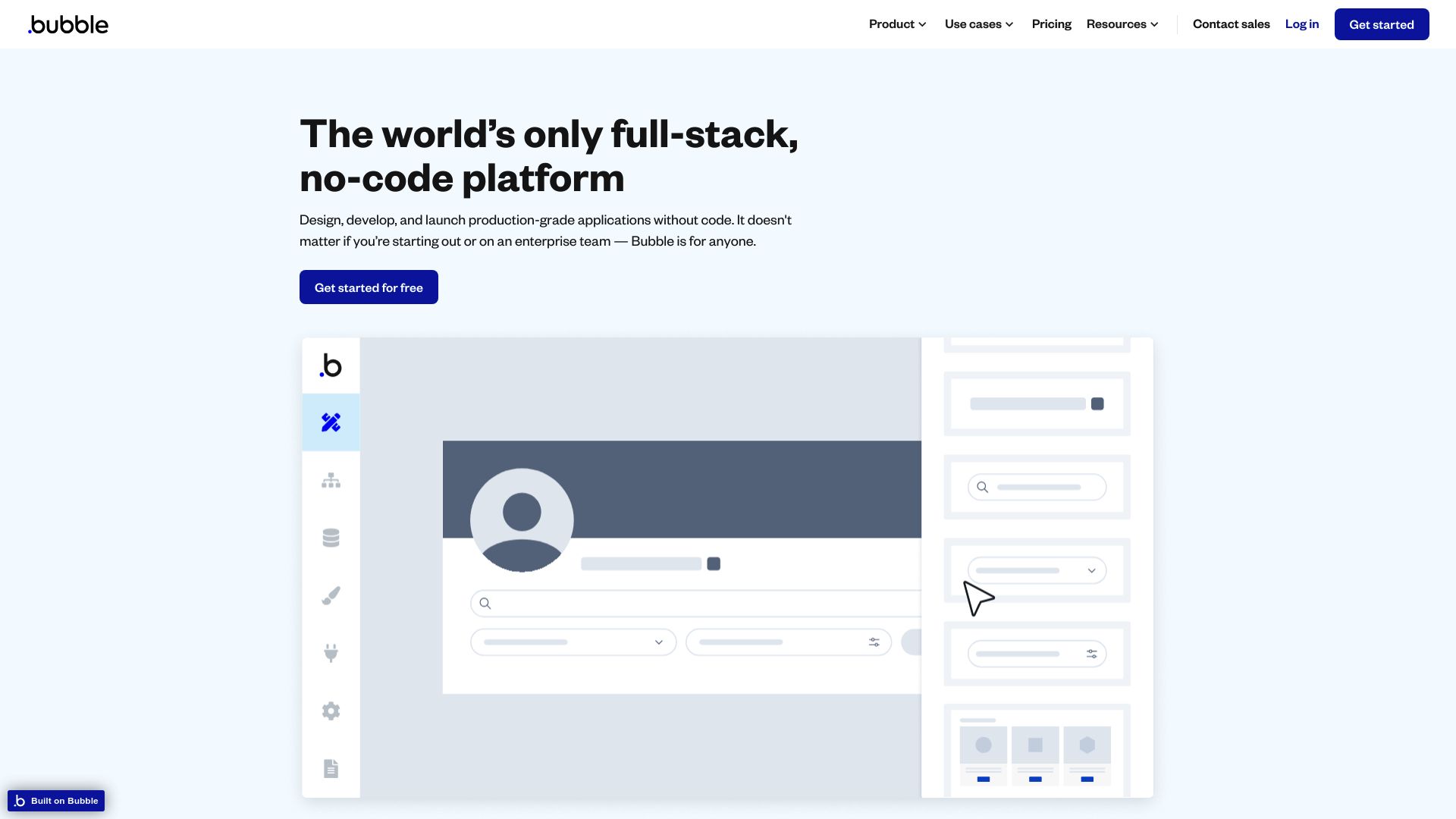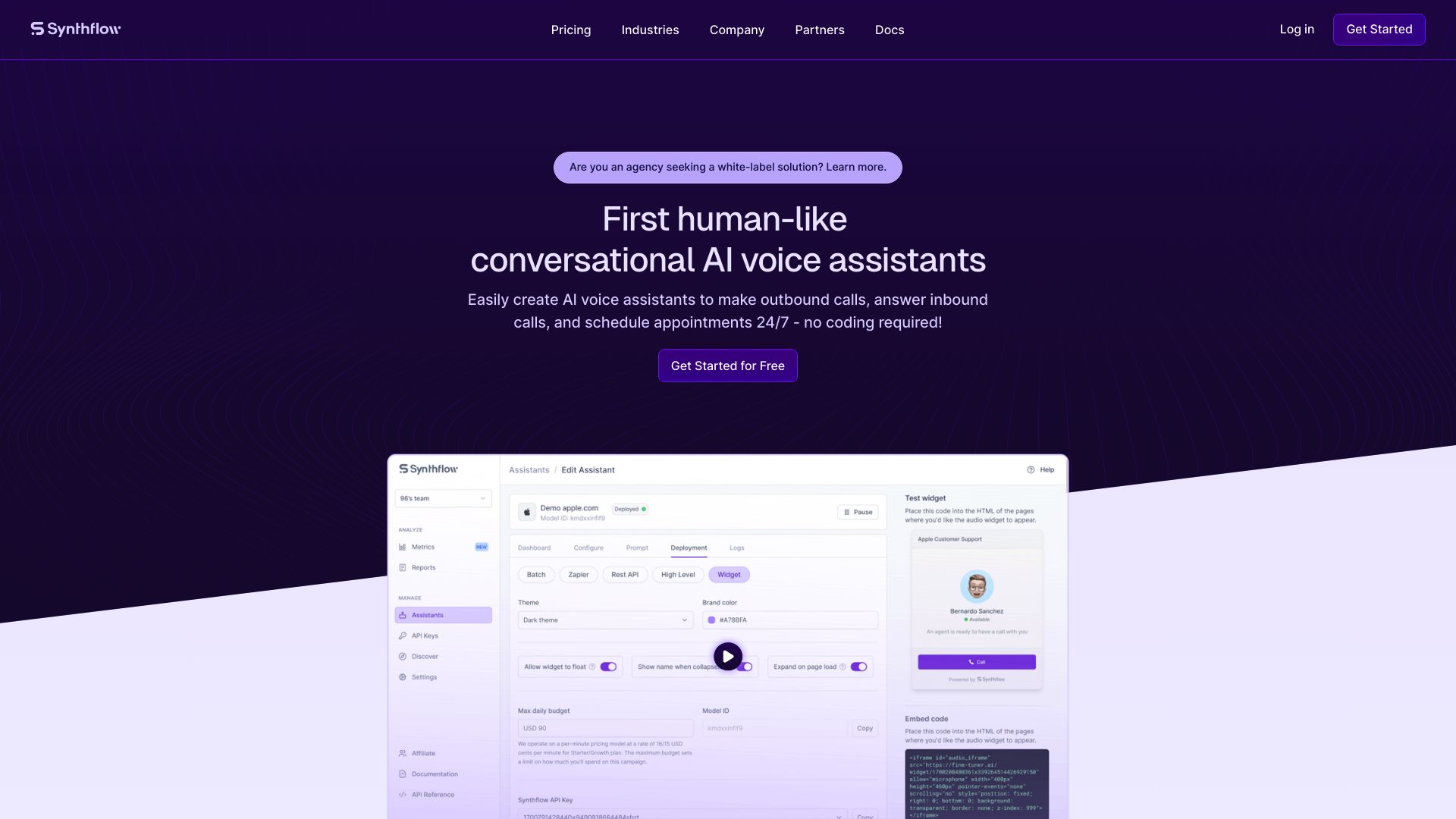Bubble vs. Synthflow: AI Tool Comparison for Developers and Business Leaders
AI technology revolutionizes business operations, but selecting the right platform can challenge even seasoned professionals. This comparison examines Bubble vs. Synthflow, and SmythOS, three distinct no-code solutions for AI integration and application development. Bubble excels in visual web app creation, Synthflow specializes in AI voice assistants, while SmythOS offers comprehensive AI agent development and deployment.
We’ll explore each platform’s strengths, limitations, and unique features to help you determine which best suits your organization’s AI ambitions. Whether you’re a developer seeking powerful APIs, a business leader focused on scalability, or an entrepreneur looking for accessible AI tools, this analysis provides the insights needed to make an informed decision in today’s competitive AI landscape.
Bubble Overview
Bubble empowers users to create web applications without writing code. This visual development platform enables entrepreneurs, business professionals, and aspiring developers to bring their ideas to life through an intuitive drag-and-drop interface.


Bubble’s no-code environment supports the creation of complex, data-driven applications. Users can design responsive interfaces, set up databases, and define workflows without traditional programming. The platform integrates with popular services and APIs, including AI technologies like OpenAI’s GPT, expanding the possibilities for app functionality.
Bubble empowers users to create web applications without writing code. This visual development platform enables entrepreneurs, business professionals, and aspiring developers to bring their ideas to life through an intuitive drag-and-drop interface.
For businesses and individuals seeking to leverage AI, Bubble offers a pathway to incorporate intelligent features into their applications. Through plugins and API connections, users can implement chatbots, content generation, and other AI-driven capabilities. This accessibility democratizes AI integration, allowing a broader audience to harness its power.
While Bubble excels in visual app development, it lacks some specialized AI agent features. The platform doesn’t natively support autonomous agents or advanced AI memory systems. Users looking for deep AI agent capabilities may need to explore additional integrations or alternative platforms. Despite these limitations, Bubble’s strength lies in its ability to rapidly prototype and deploy web applications with AI enhancements, making it a valuable tool for many projects.
Bubble’s scalable infrastructure, built on Amazon Web Services, ensures applications can grow with user demand. The platform also prioritizes security, offering features like data encryption and compliance certifications. These aspects make Bubble suitable for both small startups and enterprise-level applications, though users should consider their specific AI requirements when evaluating the platform.
Synthflow Overview
Synthflow empowers businesses to create customizable AI voice assistants without coding expertise. The platform features a no-code interface, pre-built templates, and step-by-step guidance, making advanced AI technology accessible to users with varying technical backgrounds.
The core offering revolves around AI-powered voice assistants that businesses can tailor to their specific needs. These assistants handle diverse tasks such as customer support, lead generation, appointment scheduling, and issue triaging. Synthflow prioritizes data security and compliance, providing unlimited secure storage in a dedicated Pinecone environment.
Synthflow empowers businesses to create customizable AI voice assistants without coding expertise. The platform features a no-code interface, pre-built templates, and step-by-step guidance…


Synthflow’s intuitive interface allows users to create and manage AI agents without coding skills. The platform supports batch deployments for large-scale communication campaigns and real-time interaction through website widgets. Integration capabilities extend its functionality, seamlessly connecting with tools like 11Labs and Twilio.
While Synthflow excels in creating voice assistants, it lacks some advanced features found in comprehensive AI agent builders. The platform doesn’t offer hosted AI agents for development or production environments, autonomous agents, or multi-agent collaboration. Additionally, it doesn’t provide specialized tools for explainability, transparency, or debug modes.
Synthflow’s vision centers on democratizing AI technologies for businesses of all sizes. By providing accessible tools for creating personalized AI assistants, the platform aims to streamline operations, enhance customer service, and drive growth across various industries.
Feature Comparison
Bubble and Synthflow offer distinct approaches to no-code development, with Bubble focusing on web application creation and Synthflow specializing in AI voice assistants. Bubble’s visual builder empowers users to construct complex web applications without coding, integrating AI functionalities through APIs and plugins. In contrast, Synthflow’s platform centers on crafting customizable AI voice assistants for tasks like customer support and lead generation.
Core component differences highlight Bubble’s strength in general-purpose app development versus Synthflow’s AI-centric approach. Bubble provides a robust visual interface for building responsive web applications with database integration and workflow automation. Synthflow, however, excels in voice AI technology, offering pre-built templates and step-by-step guidance for creating voice assistants with distinct personalities. This specialization allows Synthflow to deliver more advanced AI interaction capabilities out-of-the-box compared to Bubble’s general AI integration options.
Regarding security, both platforms prioritize data protection, but their approaches differ. Bubble utilizes TLS for data in transit and AES-256 encryption for data at rest, catering to web application security needs. Synthflow emphasizes AI-specific security measures, providing unlimited secure storage in a dedicated Pinecone environment, which is particularly relevant for voice data and AI model integrity. While both platforms offer OAuth support, Synthflow’s focus on AI assistants may provide more specialized security features for voice-based interactions and AI data handling.
Feature Comparison Table
| Bubble | Synthflow | SmythOS | |
|---|---|---|---|
| CORE FEATURES | |||
| Memory & Context | ❌ | ✅ | ✅ |
| Autonomous Agents | ❌ | ✅ | ✅ |
| Explainability & Transparency | ❌ | ✅ | ✅ |
| Multimodal | ❌ | ❌ | ✅ |
| Multi-Agent Collaboration | ❌ | ✅ | ✅ |
| Bulk Work | ❌ | ✅ | ✅ |
| Agent Work Scheduler | ❌ | ✅ | ✅ |
| SECURITY | |||
| Constrained Alignment | ❌ | ✅ | ✅ |
| IP Control | ❌ | ❌ | ✅ |
| COMPONENTS | |||
| Huggingface AIs | ❌ | ❌ | ✅ |
| Classifiers | ❌ | ❌ | ✅ |
| Data Lakes | ✅ | ❌ | ✅ |
| DEPLOYMENT OPTIONS (EMBODIMENTS) | |||
| Deploy as API | ❌ | ✅ | ✅ |
| Staging Domains | ✅ | ❌ | ✅ |
| Production Domains | ✅ | ❌ | ✅ |
| Deploy as Scheduled Agent | ❌ | ✅ | ✅ |
| DATA LAKE SUPPORT | |||
| Hosted Vector Database | ❌ | ✅ | ✅ |
| Sitemap Crawler | ❌ | ✅ | ✅ |
| YouTube Transcript Crawler | ❌ | ✅ | ✅ |
| URL Crawler | ❌ | ❌ | ✅ |
| PDF Support | ✅ | ❌ | ✅ |
| Word File Support | ✅ | ❌ | ✅ |
| TXT File Support | ✅ | ❌ | ✅ |
Best Alternative to Bubble and Synthflow
SmythOS stands out as the superior alternative to Bubble and Synthflow, offering a comprehensive platform for AI agent development and deployment. Our solution combines the best of both worlds: the visual building capabilities of Bubble and the AI-centric approach of Synthflow, while surpassing both in terms of features and flexibility.
We provide a user-friendly drag-and-drop interface that empowers users to create sophisticated AI agents without extensive coding knowledge. Unlike Bubble’s focus on web applications or Synthflow’s specialization in voice assistants, SmythOS offers a versatile platform for developing AI agents across various domains and use cases.
SmythOS stands out as the superior alternative to Bubble and Synthflow, offering a comprehensive platform for AI agent development and deployment.
Our platform excels in its extensive integration ecosystem, supporting a wide range of APIs, AI models, and tools. This allows users to seamlessly incorporate AI functionalities into their existing workflows and systems. While Bubble relies on plugins for AI integration and Synthflow focuses solely on voice AI, SmythOS provides native support for multiple AI models and APIs, offering unparalleled flexibility and power.
SmythOS takes security and scalability seriously. We offer robust data encryption, OAuth support, and IP control features, ensuring that your AI agents and data remain secure. Our platform is designed to scale effortlessly, supporting enterprise-level deployments while maintaining performance and reliability. This makes SmythOS an ideal choice for businesses of all sizes, from startups to large corporations.
With SmythOS, users can deploy AI agents in various forms, including APIs, webhooks, scheduled tasks, and even as ChatGPT plugins. This versatility, combined with our multi-agent collaboration capabilities and advanced features like bulk work processing and work scheduling, sets SmythOS apart as the most comprehensive and powerful AI agent builder in the market. Choose SmythOS for unlimited possibilities in AI automation and innovation.
Conclusion
Bubble, Synthflow, and SmythOS each offer unique approaches to no-code development and AI integration. Bubble excels in general-purpose web application creation, allowing users to build complex apps without coding. Synthflow specializes in AI voice assistants, providing an accessible platform for businesses to create customized AI-driven communication tools. However, SmythOS stands out as the most comprehensive and versatile solution for AI agent development and deployment.
SmythOS’s drag-and-drop interface, extensive integration ecosystem, and support for multiple AI models make it the superior choice for businesses looking to harness the full potential of AI. Unlike Bubble and Synthflow, SmythOS offers advanced features such as multi-agent orchestration, versatile deployment options, and a vast library of pre-built components and templates. These capabilities enable users to create sophisticated AI workflows that can be seamlessly integrated into existing systems and deployed across various platforms.
While Bubble and Synthflow may be suitable for specific use cases, SmythOS’s flexibility and power make it the ideal choice for businesses seeking to innovate and automate at scale. Its ability to support the creation of APIs, chatbots, and other AI-driven applications with minimal effort sets it apart from competitors. Furthermore, SmythOS’s vision of making AI agent creation and deployment 99% faster aligns perfectly with the growing demand for efficient, accessible AI solutions in today’s fast-paced business environment.
To experience the transformative power of SmythOS for yourself, explore our diverse range of AI-powered agent templates or create a free SmythOS account to start building your own AI agents today. With SmythOS, you’ll be at the forefront of the AI revolution, equipped with the tools to drive innovation and efficiency in your organization.
Last updated:
Disclaimer: The information presented in this article is for general informational purposes only and is provided as is. While we strive to keep the content up-to-date and accurate, we make no representations or warranties of any kind, express or implied, about the completeness, accuracy, reliability, suitability, or availability of the information contained in this article.
Any reliance you place on such information is strictly at your own risk. We reserve the right to make additions, deletions, or modifications to the contents of this article at any time without prior notice.
In no event will we be liable for any loss or damage including without limitation, indirect or consequential loss or damage, or any loss or damage whatsoever arising from loss of data, profits, or any other loss not specified herein arising out of, or in connection with, the use of this article.
Despite our best efforts, this article may contain oversights, errors, or omissions. If you notice any inaccuracies or have concerns about the content, please report them through our content feedback form. Your input helps us maintain the quality and reliability of our information.
